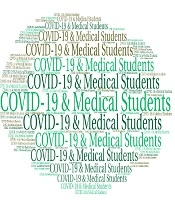Dear editor,
COVID-19 pandemic has had a profound effect on education. Different countries have given different responses to the pandemic, a spectrum from the complete closure of universities to early graduation. In Chile, Ecuador, Honduras, Mexico, the Dominican Republic, and Venezuela, most medical schools have suspended medical internships (1). In Nepal, a program was performed for the early graduation of final-year medical students (2). In New York and other states of the United States, senior students are given the choice to graduate early. The Association of American Medical Colleges (AAMC) has ordered medical schools to suspend student work “unless the health care workforce is in need”. The closure has led to severe confusion, frustration, and panic among students (3).
In Iran, all undergraduate schools of medical universities were closed. However, the final-year medical students had to stay and complete their course. Four months after the announcement of the first case of COVID-19, new instructions were issued for the reopening of universities. Some countries, such as Iran, passed laws to the use of voluntary students in the pandemic, and 150 native medical students voluntarily enrolled in the campaign of the Jahrom University of Medical Sciences.
They performed the activities, including translation of the book “handbook of COVID-19 prevention and treatment” from Chinese to Persian, more than 1000 hours of community and health education to vendors, production of 30 educational posters and podcasts, telephone screening, passenger screening, disinfection of vehicles and the city, and setting up a convalescent home. They also produced 35,000 masks and bought 100 face shields and personal protective equipment (PPE) with the help of charity. They implemented support programs for nurses and launching a campaign to support them. They also provided protective equipment for patients suffering from chronic diseases, such as hemodialysis and multiple sclerosis.
Other examples in the America and Portuguesa can be named, such as carrying out clerical work, production and distribution of personal protective equipment, virtual consulting, educating patients and their families, translation of educational tracts, community education, preparation and distribution of support and health packages, telephone triage, nursing assistants, and assistance in providing ventilator (4-6).
Medical students are willing and able to fight this historic pandemic. They succeed in finding their way to do an activity. Their voluntary activities enabled us to take advantage of their great potential. These activities reduced the workload of the staff, the students observed the efficiency of the health system and achieved experience in providing services in critical epidemic situations. Thus, with proper legal, operational, and educational measures, medical students can play an effective role in disasters.
